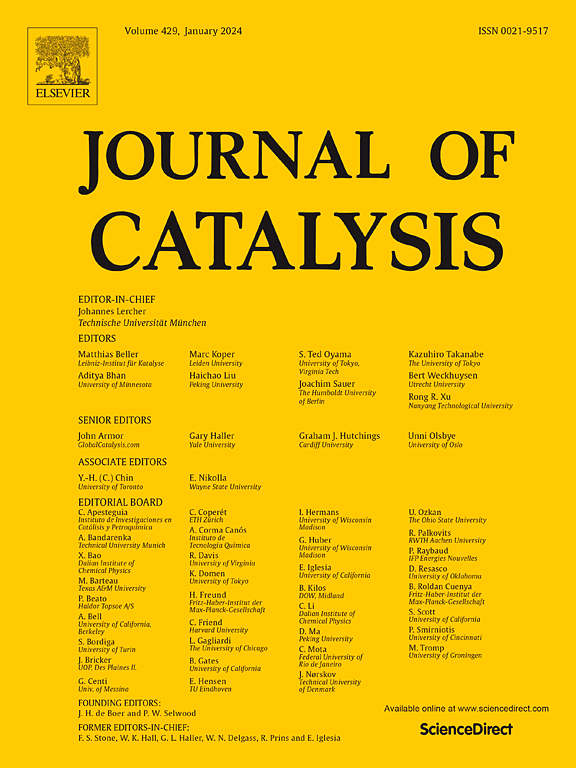Consequences of altering acid strength in MFI zeolites via phosphorus modification on Friedel-Crafts acylation
IF 6.5
1区 化学
Q2 CHEMISTRY, PHYSICAL
引用次数: 0
Abstract
Friedel-Crafts acylation is an important reaction for the formation of C![]() C bonds to produce a variety of commodity chemicals. Recent efforts have been made to reduce the environmental footprint of these reactions by utilizing renewable carboxylic acids directly (rather than halogenated species), using renewable acyl acceptors, and using zeolites as non-sacrificial catalysts. While the direct conversion of acids to valuable products is appealing, the role of acid strength and local environment on rates and stability for this reaction is unknown. Here we report the acylation of 2-methylfuran with acetic acid over phosphorus-modified MFI zeolites with various phosphorus loadings. We show that while P modification increases observed activation barriers for acylation when compared with traditional Bronsted sites, net rates of reaction can be increased. Further, selectivity is improved by reduced rates of acid self-coupling side reactions to a greater extent. Importantly, the phosphorus-modified samples also exhibit slower coke formation, and therefore deactivation, due to diminished side reactions.
C bonds to produce a variety of commodity chemicals. Recent efforts have been made to reduce the environmental footprint of these reactions by utilizing renewable carboxylic acids directly (rather than halogenated species), using renewable acyl acceptors, and using zeolites as non-sacrificial catalysts. While the direct conversion of acids to valuable products is appealing, the role of acid strength and local environment on rates and stability for this reaction is unknown. Here we report the acylation of 2-methylfuran with acetic acid over phosphorus-modified MFI zeolites with various phosphorus loadings. We show that while P modification increases observed activation barriers for acylation when compared with traditional Bronsted sites, net rates of reaction can be increased. Further, selectivity is improved by reduced rates of acid self-coupling side reactions to a greater extent. Importantly, the phosphorus-modified samples also exhibit slower coke formation, and therefore deactivation, due to diminished side reactions.


磷改性对Friedel-Crafts酰化改变MFI沸石酸强度的影响
Friedel-Crafts酰化反应是形成CC键以生产各种商品化学品的重要反应。最近,人们通过直接使用可再生羧酸(而不是卤化物质)、使用可再生酰基受体和使用沸石作为非牺牲催化剂来减少这些反应的环境足迹。虽然酸直接转化为有价值的产品很有吸引力,但酸强度和当地环境对该反应的速率和稳定性的作用尚不清楚。在这里,我们报道了2-甲基呋喃与乙酸在不同磷负荷的磷改性MFI沸石上的酰化反应。我们发现,虽然与传统的Bronsted位点相比,P修饰增加了观察到的酰化激活屏障,但净反应速率可以增加。此外,选择性的提高是由于在很大程度上降低了酸自偶联副反应的速率。重要的是,磷修饰的样品也表现出较慢的焦炭形成,因此失活,由于减少副反应。
本文章由计算机程序翻译,如有差异,请以英文原文为准。
求助全文
约1分钟内获得全文
求助全文
来源期刊

Journal of Catalysis
工程技术-工程:化工
CiteScore
12.30
自引率
5.50%
发文量
447
审稿时长
31 days
期刊介绍:
The Journal of Catalysis publishes scholarly articles on both heterogeneous and homogeneous catalysis, covering a wide range of chemical transformations. These include various types of catalysis, such as those mediated by photons, plasmons, and electrons. The focus of the studies is to understand the relationship between catalytic function and the underlying chemical properties of surfaces and metal complexes.
The articles in the journal offer innovative concepts and explore the synthesis and kinetics of inorganic solids and homogeneous complexes. Furthermore, they discuss spectroscopic techniques for characterizing catalysts, investigate the interaction of probes and reacting species with catalysts, and employ theoretical methods.
The research presented in the journal should have direct relevance to the field of catalytic processes, addressing either fundamental aspects or applications of catalysis.
 求助内容:
求助内容: 应助结果提醒方式:
应助结果提醒方式:


